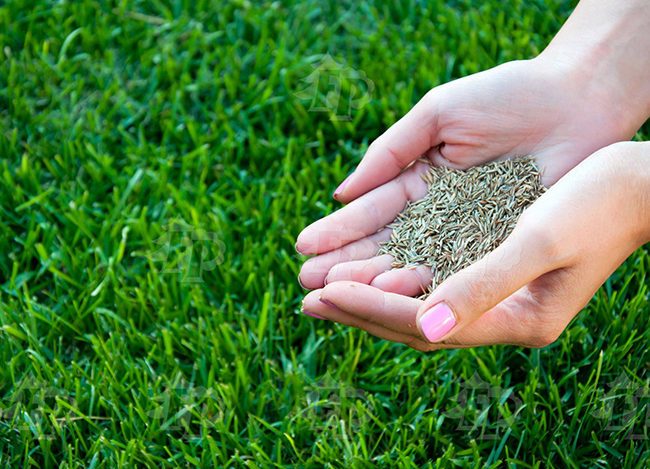Lawn care – autumn seeding of the lawn.
Fall seeding is an important part of your lawn care. If you take care to plant enough grass seed in the fall, you will have a beautiful lawn in the spring. There are many reasons why fall is better than spring for planting lawn grass. First, warmer soil temperatures are more conducive to seed germination. Secondly, the seeds, which will already gain strength in the spring, will have less competition from weeds.

Lawn seeding is the process of spreading grass seed over established turf. Lawn seeding is usually done only when the area of the lawn is damaged or not growing very well. However, the Green Yard garden center recommends seeding the lawn every year. Herbaceous plants become thinner over time and lose some of their density. Regular seeding allows you to fill any gaps in your lawn and prevent the appearance of weeds in the spring in places where the lawn has grown worse. A denser lawn will be less prone to trampling and natural weathering.

Prevention of soil erosion.
In addition to the benefits of fall seeding such as weed control and thicker grass, this process also prevents soil erosion. A densely seeded lawn will hold water and soil where you need it. To improve the overall condition of your lawn, you can sow your lawn with seeds that are resistant to diseases or pests. Late summer and early fall are great times to “renovate” your lawn, because the light and steady rain typical of these seasons will aid in grass seed germination. However, be careful because a heavy rain, immediately after the work done, can simply wash away most of your crop.

To make sure that you sow the lawn correctly, it would be advisable to perform the work in several subsequent stages. If you have problems with any of the steps listed below, you can always ask for help from the experts in landscape design and lawn care at the Green Yard garden center.

1) Prepare your lawn by mowing the lawn (to a height of about 7 cm) and removing debris so that the new seeds get into the soil and start germinating sooner. 2) Aerate the soil in those areas of the lawn where it is most damaged (trampled). The rate of germination where there are trampled areas is extremely low, so be sure to use an aerator.
3) Check the PH level of the soil and adjust it if necessary. Maintaining the correct PH balance will make your lawn healthier and easier to grow. You can use the necessary fertilizers to change the PH of the soil under your lawn.
4) Cover bare areas of the lawn with straw or mulch to preserve moisture and lawn grass seeds as much as possible.
If you are interested in learning more about care for your lawn, contact the landscape design experts at Green Yard Garden Center. We provide a wide range of landscaping services, from lawn, tree and shrub maintenance to landscape design and construction of patios, summer areas, and swimming pools.

You can contact us forlawn care, lawn seeding, and also visit our garden center store Mon-Fri from 8:30 a.m. to 6:00 p.m.

